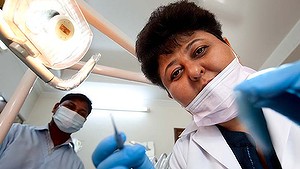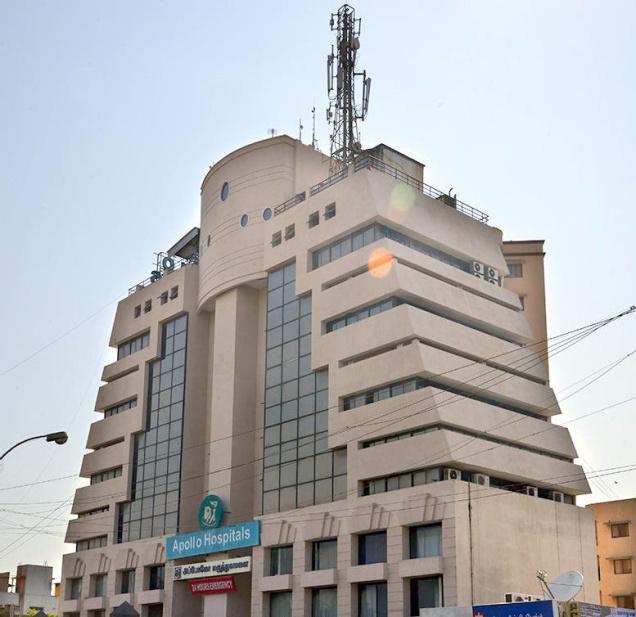
HIgh quality, low prices: Dr. Poonam Batra’s Delhi dentist service. / Photo: Graham Crouch
Medical tourism is a growing international phenomenon.
A dental problem, a strong Australian dollar and a ticket to India: it was the perfect combination for my own ”off-shoring” project. It began when my dentist surprised me with a $2500 quote to have a tooth capped. Luckily, I was about to take a three-week holiday on the subcontinent.
India is known for its flamboyant street dentists who’ll pull a tooth for less than $2 while you sit on the footpath. But India’s rapidly expanding middle-class demands more sophisticated treatment. Medieval dental traditions are now offered side-by-side with state-of-the-art clinics staffed by well-trained dentists.
I made an appointment with Poonam Batra, a dentist in Delhi, to see if she could fix my tooth. Her neat waiting room was reassuring, especially a large pin-board with photos of Dr Batra with prominent clients from Delhi’s diplomatic corps including a former US ambassador and Australian high commissioner. If they had treatment here how could I go wrong?
The inside of Batra’s surgery looked just as high-tech and hygienic as any I’ve been to in Sydney and her two studious-looking male dental assistants could have passed for IT consultants.
The straight-talking Batra recommended similar (although not identical) treatment to what my Sydney dentist had advised. The two sessions I required in the chair over the course of a week went like clockwork. After each visit I received a text message from the surgery saying: ”Hello Sir. Just checking-up. How are you feeling?”
With service like this on offer at a fraction of the price of an Australian dentist, its no surprise the number of people having their teeth fixed in Asia is rising.
Cassandra Italia, from medical tourism company Global Health Travel, estimates at least 25,000 Australians went on a dental tour last year.
”Going overseas for medical treatment used to be quite frowned upon,” Italia says. ”There was a stigma associated with it because people thought you would be compromising on quality. But now there’s much more awareness in the community about medical tourism and it’s growing very fast every year.”
Dental care is a thriving subset of a worldwide medical tourism boom that has lasted more than a decade. Figures on the size of this market are sketchy but some estimates put its value at more than $US100 billion ($95.4 billion) a year. Anita Medhekar, a Central Queensland University economist who researches medical tourism, says the industry is still at least a decade from maturity and destined for further strong growth.
Thailand is recognised as the market leader in medical tourism. Its tourism authority says 1.5 million foreigners visited Thai hospitals in 2008 generating about $US6 billion for the Thai economy. Bangkok’s huge Bumrungrad International Hospital has been tagged the world’s first ”global hospital” and treats more than 400,000 foreigners a year. Bumrungrad has more than 30 medical specialties including dental services. But Thailand faces stiff competition in the medical tourism market especially from India, Singapore, the Philippines and Malaysia.
India’s low wages make it one of the cheapest destinations for medical tourism. The subcontinent also has a vast pool of well-trained medical professionals, many with Western training, and English is widely spoken. The growth of the Indian economy has been matched with rapid growth in high-quality medical facilities. Specialist ”medi-cities” featuring luxury accommodation and research facilities have been built near large cities to target growing offshore demand. One in Gurgaon, near Delhi, is spread over 17 hectares, has 45 operating theatres and caters for more than 20 medical specialities.
Lynne Pezzullo, a Deloitte Access Economics health economist, says the ”invisible hand” of market forces has been fundamental in the medical tourism boom.
”People are going to where the resources are relatively cheaper – Australia, of course, has very costly specialised and highly skilled labour,” she says.
”That means people will go to where they can get a similar level of service at perhaps a substantially lower cost.”
But other forces are also at work.
”Part of it is the rising costs of health care in Western countries, differences in quality and accessibility of services, information technology, lower transport costs, reduced language barriers and trade liberalisation,” says Pezzullo, who wrote a report about medical tourism in Australia for the federal government in 2011.
Italia believes social media has also helped legitimise medical tourism and stoke demand.
”Some patients are posting videos of their treatment on YouTube and people are getting on the internet and seeing people’s testimonials,” she said. ”That creates feelings of safety and security.”
Italia says demand for dental tourism is growing faster than other treatments such as cosmetic surgery and IVF. Her firm experienced a 40 per cent increase in demand for dental trips between 2011 and 2012.
Medhekar says people with little or no dental insurance are the most likely to opt for treatment in Asia.
”Demand for offshore dental work will grow because these services are not easily available and affordable for everyone here in Australia,” she says.
However, Pezzullo points out that the cost of overseas travel and accommodation means dental tourism is still out of reach for many low-income families.
”Among middle-income and upper-income Australians the options to go overseas for dental care are becoming more relatively attractive,” she said.
”The people that miss out twice are lower income and disadvantaged people who may have very acute dental conditions – with a lot of pain. They might be self-medicating because of a lack of access to dental care but are also excluded from going overseas for care because they can’t afford the travel.”
Treating a foreign traveller was nothing new for my Indian dentist – Poonam Batra has been peering into the mouths of dental tourists for 17 years. They have helped her build a thriving practice with five specialists offering a range of services. Her foreign patients normally have ”email consultations” before arriving in India and then arrange their travel around their dental work.
”The dental tourism trend has persisted and the volume of my tourist patients has gone up,” Batra says. ”Now they fly in and out for root canals, crown and bridge work, veneers, wisdom-teeth extractions and implants.”
”The wonderful thing is some come back repeatedly and bring friends or family.”
I was surprised by how much my off-shoring project saved me. Dr Batra charged $312.90 for my treatment, about one-eighth of what I was quoted in Sydney. In effect, the scheme paid for my airfare. But many dental tourists save far more than I did – Ms Cassandra Italia cites examples of people having dental work that would have cost $50,000 in Australia done for $15,000 in Asia.
So are Australian dentists worried about off-shoring? Chief executive of the Australian Dental Association Robert Boyd-Boland says any profession would be uneasy if business was going offshore because of price.
”It is a concern that there’s a market overseas that’s taking work that Australian dentists might otherwise be able to undertake,” he says.
The profession’s response has been to highlight the quality of Australian dental services and warn of the risks of having treatment abroad.
The association says there has been a ”disturbing increase in the number of Australians returning from overseas having received dental treatment with problems that are very difficult to address”.
It also warns that infection control standards are less rigorous in some other countries. Boyd-Boland says serious dental problems often require months of treatment and many dental tourists are in danger of rushing complex procedures.
”If it all blows up and there’s a need to have it fixed here in Australia the expenses will escalate and the saving that a patient thought they’d make will well and truly be lost,” he says.
Many Asian medical centres have responded to concerns about quality and hygiene by gaining top-level accreditation. Even so, Batra says dental tourists need to be careful. ”Things can go very wrong. The best referral is word of mouth really.”
source: http://www.m.smh.com.au / Home> Travel> Travel News / by Matt Wade / April 05th, 2013



